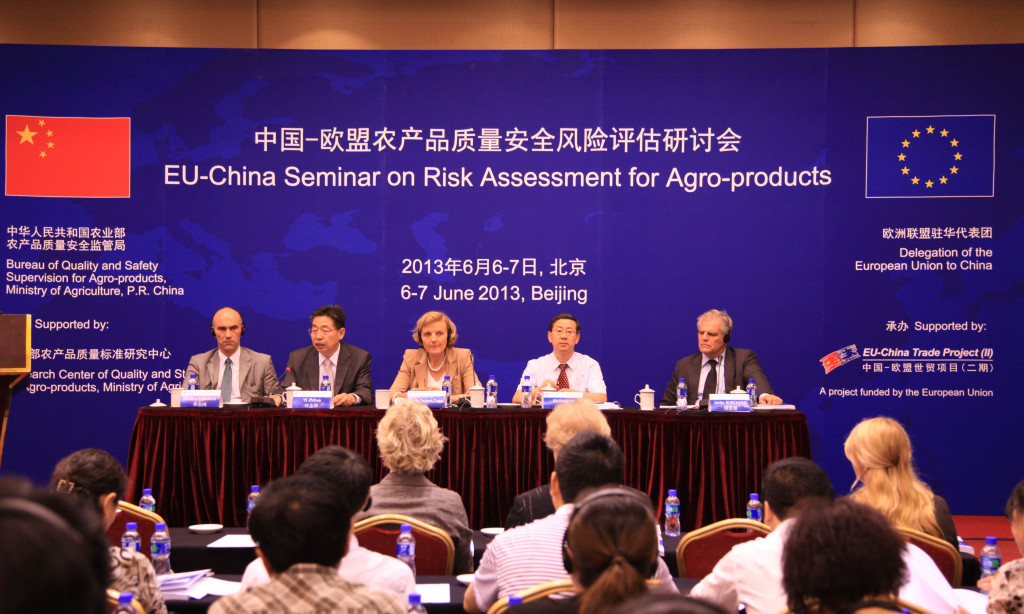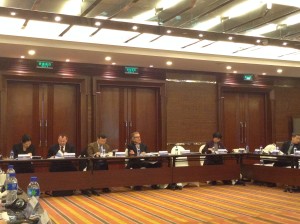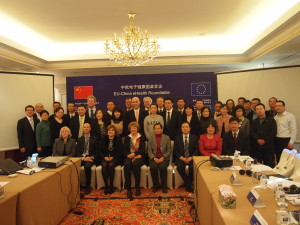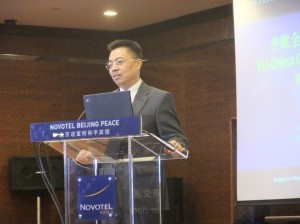Launched in 2004, the EU-China Trade Project (EUCTP), is the largest trade and investment-related cooperation project with China. Now in its second iteration—the EUCTP II—the project will have delivered more than 400 activities when it concludes in 2015. Carl Hayward met with Project Team Leader Philip Bartley to find out about the progress it has made and discuss some of its major achievements.
The EUCTP is a trade technical assistance project funded by the European Union to assist the Chinese Government with capacity building and institutional strengthening, and to help establish trade and economic policy, legislative and regulatory frameworks in line with international standards. This supports China’s obligations to comply with international agreements, chiefly as a member of the World Trade Organisation (WTO).
EUCTP has evolved considerably since its original design to support everything under China’s WTO accession mandate. Now, the project breaks down into five linked components: Services, including banking, legal, securities, insurance, telecommunications, creative and tourism; Quality Infrastructure, including standardisation, technical regulations, conformity assessment and testing, and market surveillance; Agriculture and Food Safety; Customs; and a Cross-Cutting Component, including competition policy, public procurement, sustainable trade and low carbon economy, WTO issues, investment rules, corporate social responsibility and market access.
Bartley says that the benefit of the project for China is the opportunity to learn from the experiences of the EU, which already has a relatively mature policy, legal and regulatory framework in all aspects of trade and investment. China has identified that the continuation of its economic development relies on harmonisation with international standards and agreements that govern most trade and investment areas, and as the EU has been a pioneering contributor to many of these international standards it provides a valuable reference point for China as it puts in place its own legal and regulatory framework.
The benefit for the EU, Bartley says, is that China can become part of the international trading environment where the same rules apply. “This is part of Europe’s external trade policy, to harmonise rules and create a level playing field for all players. Projects like this assist China in reaching these common objectives.”
The two phases of the project are a reflection of China’s progress in this area, and its changing relationship with the EU. The EUCTP I was more focussed on helping China to implement its regulatory framework following its WTO accession, whereas the EUCTP II has shifted its focus much more to EU-China bilateral trade issues. The relationship has deepened between the two regions, and they are now involved less with points of academic discussion and more on the practical challenges of fine tuning China’s longer-term, sustainable trade and investment policies. There are now around 20 EU-China dialogues covering trade and related issues, and Bartley holds this as clear example of the importance of the relationship which the project reflects.
“If you want to look at how intense Europe’s relationship is with a certain country, in terms of trade, you have to look at the strength of the political and official dialogues and working groups,” says Bartley. “With China it’s extremely strong, whereas some smaller countries may have just one dialogue covering a whole range of issues. With China there’s a lot of real stuff getting done, because China is such a huge and growing trade partner for Europe.”
Bartley also measures the importance and success of the project by the level of detail that both sides are going into, as well as the political level of people that they are dealing with on the Chinese side. Around 15 per cent of EUCTP’s activities deal directly with the State Council’s legislative drafting office which, Bartley says, is the highest level of impact you can have on any technical assistance project. “If you look at our financial services activities for example, we are dealing with issues of China’s renminbi convertibility and China’s monetary policy. These are not training or academic debates, they are part of the ongoing reform agenda,” he says.
He believes that China’s perception of the EUCTP has been positive since its inception and that key ministries now view the project as contributing to its overall framework for supporting its reform. Some EU-China dialogues at the official, political level are very well advanced and there exists a real synergy and understanding between what a particular directorate-general and a ministry wants to achieve together. The outputs of work under such dialogues can therefore set new benchmarks for what is possible and inspire other EU-China dialogue partners to resolve differences and be more ambitious.
Where frictions can exist in the EU-China dialogues the flexible project scope allows both sides to address the problems and identify areas of mutual interest, such as how to achieve a low carbon economy or sustainable urbanisation. The project scope provides opportunities for joint innovation and exploring new approaches to resolving frictions, such as in intellectual property protection. Achieving progress within individual dialogues he acknowledges requires the best efforts of both sides.
Now in its penultimate year, the EUCTP should be considered a success due to the support it provides to the EU-China trade dialogues, the level of discussion and the backing that it has received from the Chinese Government and European Commission at all levels. Chinese interlocutors in the dialogues have included ministries, and the State Council, the National People’s Congress and the Communist Party who have all put their weight behind the decisions that have been taken on the Chinese side. This is something that Bartley says is unique for a technical assistance project, as the vast majority of trade or other types of projects are not so deeply connected to the political hierarchy, and for this reason do not receive the amount of attention they perhaps deserve.
Another indicator of the success of the project is the number of laws that it has been directly involved in supporting in terms of legislative drafting, laws that can take a considerable amount of time to be promulgated. Most notably, they have worked on the Anti-Monopoly Law, Insurance Law (revision), Patent Law (revision), Trademark Law (revision), Telecommunication Law, Environmental Protection Law (revision), Securities Investment Funds Law (revision), Mutual Assistance on Criminal Matters, Administrative Enforcement, Copyrights Law (revision), Tourism Law, Asset Evaluation Law, Credit Reporting Regulation and Energy Law. For some of these laws the EUCTP was involved from the very beginning. At the first stage they were involved with a ministry, with the law then being passed to the State Council before receiving final approval from the National People’s Congress, a process that could take four or five years.
In the area of competition policy, in addition to supporting the Anti-monopoly Law, DG Competition is now working with the Chinese anti-monopoly enforcement bodies to share administrative practices and gather information on cross-border cases.
Low carbon is another area, particularly in the last three years where China is putting together a lot of policy, regulations and new standards to increase renewable energy and improve energy efficiency of buildings. This is another area where the EUCTP has done a great deal of work.
Bartley also points towards to the work that they have carried out in the financial services sector, having carried out more than 100 activities with the People’s Bank of China, the Banking Regulatory Commission and the Securities Regulatory Commission over the last eight years. “This is a huge body of work,” says Bartley, “and directly inputting to China’s reform agenda.” Currently the trade and investment landscape is becoming an increasing priority for the project as DG Trade and the Ministry of Commerce (MOFCOM) prepare for deeper ties.
It is known that China no longer qualifies for assistance as a developing country now that it is considered to be an industrialised country, so in future the instruments that fund technical assistance will no longer be available to them. However, given the importance of the EU-China relationship, there is ongoing exploration into fresh instruments, new budgets and different ways of cooperating which are perhaps more geared towards mutual interest with matched funding. Each side would invest in future cooperation and then work together on similar kinds of mechanisms, but within a different framework. However, with the project set to conclude in 2015 any future plans lie with the European Commission and the Chinese Government.
After nearly 10 years, Bartley says that China’s dynamic development and the ever-changing EU-China relationship have kept the project feeling fresh. “It’s almost as if we have reinvented ourselves every year,” he says. “This year is the Free Trade Zone and launch of EU-China Investment Treaty while last year we saw the early reforms of the new government, so we’ve constantly had to realign ourselves with these new political instruments and the development challenges that China has identified. There’s never a dull day.”






Recent Comments